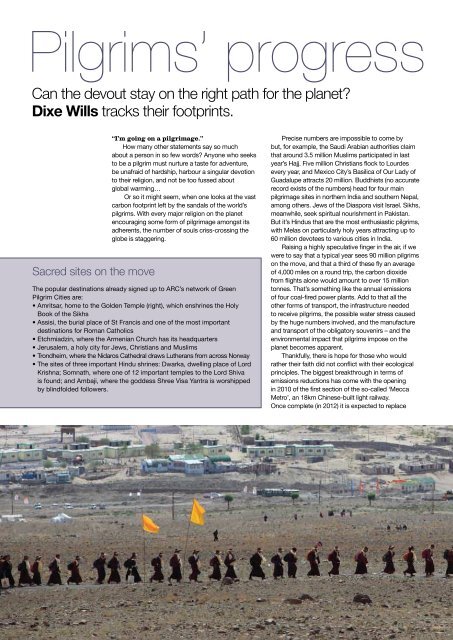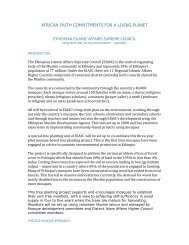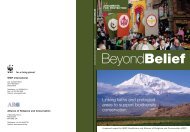here - Alliance of Religions and Conservation
here - Alliance of Religions and Conservation
here - Alliance of Religions and Conservation
You also want an ePaper? Increase the reach of your titles
YUMPU automatically turns print PDFs into web optimized ePapers that Google loves.
Pilgrims’ progress<br />
Can the devout stay on the right path for the planet?<br />
Dixe Wills tracks their footprints.<br />
Sacred sites on the move<br />
“I’m going on a pilgrimage.”<br />
How many other statements say so much<br />
about a person in so few words? Anyone who seeks<br />
to be a pilgrim must nurture a taste for adventure,<br />
be unafraid <strong>of</strong> hardship, harbour a singular devotion<br />
to their religion, <strong>and</strong> not be too fussed about<br />
global warming…<br />
Or so it might seem, when one looks at the vast<br />
carbon footprint left by the s<strong>and</strong>als <strong>of</strong> the world’s<br />
pilgrims. With every major religion on the planet<br />
encouraging some form <strong>of</strong> pilgrimage amongst its<br />
ad<strong>here</strong>nts, the number <strong>of</strong> souls criss-crossing the<br />
globe is staggering.<br />
The popular destinations already signed up to ARC’s network <strong>of</strong> Green<br />
Pilgrim Cities are:<br />
• Amritsar, home to the Golden Temple (right), which enshrines the Holy<br />
Book <strong>of</strong> the Sikhs<br />
• Assisi, the burial place <strong>of</strong> St Francis <strong>and</strong> one <strong>of</strong> the most important<br />
destinations for Roman Catholics<br />
• Etchmiadzin, w<strong>here</strong> the Armenian Church has its headquarters<br />
• Jerusalem, a holy city for Jews, Christians <strong>and</strong> Muslims<br />
• Trondheim, w<strong>here</strong> the Nidaros Cathedral draws Lutherans from across Norway<br />
• The sites <strong>of</strong> three important Hindu shrines: Dwarka, dwelling place <strong>of</strong> Lord<br />
Krishna; Somnath, w<strong>here</strong> one <strong>of</strong> 12 important temples to the Lord Shiva<br />
is found; <strong>and</strong> Ambaji, w<strong>here</strong> the goddess Shree Visa Yantra is worshipped<br />
by blindfolded followers.<br />
Precise numbers are impossible to come by<br />
but, for example, the Saudi Arabian authorities claim<br />
that around 3.5 million Muslims participated in last<br />
year’s Hajj. Five million Christians flock to Lourdes<br />
every year, <strong>and</strong> Mexico City’s Basilica <strong>of</strong> Our Lady <strong>of</strong><br />
Guadalupe attracts 20 million. Buddhists (no accurate<br />
record exists <strong>of</strong> the numbers) head for four main<br />
pilgrimage sites in northern India <strong>and</strong> southern Nepal,<br />
among others. Jews <strong>of</strong> the Diaspora visit Israel. Sikhs,<br />
meanwhile, seek spiritual nourishment in Pakistan.<br />
But it’s Hindus that are the most enthusiastic pilgrims,<br />
with Melas on particularly holy years attracting up to<br />
60 million devotees to various cities in India.<br />
Raising a highly speculative finger in the air, if we<br />
were to say that a typical year sees 90 million pilgrims<br />
on the move, <strong>and</strong> that a third <strong>of</strong> these fly an average<br />
<strong>of</strong> 4,000 miles on a round trip, the carbon dioxide<br />
from flights alone would amount to over 15 million<br />
tonnes. That’s something like the annual emissions<br />
<strong>of</strong> four coal-fired power plants. Add to that all the<br />
other forms <strong>of</strong> transport, the infrastructure needed<br />
to receive pilgrims, the possible water stress caused<br />
by the huge numbers involved, <strong>and</strong> the manufacture<br />
<strong>and</strong> transport <strong>of</strong> the obligatory souvenirs – <strong>and</strong> the<br />
environmental impact that pilgrims impose on the<br />
planet becomes apparent.<br />
Thankfully, t<strong>here</strong> is hope for those who would<br />
rather their faith did not conflict with their ecological<br />
principles. The biggest breakthrough in terms <strong>of</strong><br />
emissions reductions has come with the opening<br />
in 2010 <strong>of</strong> the first section <strong>of</strong> the so-called ‘Mecca<br />
Metro’, an 18km Chinese-built light railway.<br />
Once complete (in 2012) it is expected to replace<br />
Photos: ARC; Kazuyoshi Nomachi / Corbis<br />
approximately 30,000 car journeys a day during the<br />
Hajj. A high-speed rail network linking Mecca with the<br />
holy city <strong>of</strong> Medina <strong>and</strong> the port <strong>of</strong> Jedda is also on<br />
the drawing board.<br />
Another significant move came at an International<br />
Islamic Green Movement meeting in Jakarta, with a<br />
clarion call to governments to green up their respective<br />
Islamic holy sites. The Saudi authorities have already<br />
responded with plans to switch mosques, hotels <strong>and</strong><br />
banqueting suites over to solar power.<br />
So what might a truly sustainable pilgrimage<br />
look like? For an idea, one could do worse than<br />
examine the Way <strong>of</strong> St James routes to Santiago<br />
de Compostela in north-western Spain. Christians<br />
traditionally make the journey to the city on foot <strong>and</strong><br />
are encouraged to live simply, using small wayside<br />
inns or specially provided hostels. Rather than have<br />
one prescribed route, the physical impact <strong>of</strong> the<br />
pilgrimage on local fauna, flora <strong>and</strong> water tables<br />
is dissipated by a network <strong>of</strong> paths spread across<br />
Western Europe for the faithful to follow.<br />
Hoping to make such examples more<br />
mainstream, ARC has launched the Green Pilgrim<br />
Cities network [see ‘Sacred sites on the move’].<br />
Devised by representatives <strong>of</strong> nine <strong>of</strong> the world’s<br />
major religions, the network’s vision is to inspire both<br />
the journey-makers <strong>and</strong> their destinations to act<br />
more sustainably.<br />
“The plan for the city <strong>of</strong> Jerusalem is initially<br />
to green the infrastructure through initiatives<br />
such as the new light rail system currently under<br />
construction”, notes ARC’s Alison Hilliard. “The<br />
Etchmiadzin greening plan includes <strong>of</strong>fering pilgrims<br />
affordable <strong>and</strong> healthy traditional food, installing<br />
solar panels at the Gevorgyan Theological University,<br />
<strong>and</strong> setting up twenty sustainable bed <strong>and</strong> breakfast<br />
facilities for pilgrims.”<br />
Kusum Vyas, ARC representative <strong>and</strong> President<br />
<strong>of</strong> the Texas-based Living Planet Foundation, was<br />
encouraged by a visit to the state <strong>of</strong> Gujarat in India,<br />
w<strong>here</strong> the cities <strong>of</strong> Dwarka, Somnath <strong>and</strong> Ambaji have<br />
been drawing up their eco-pilgrimage plans:<br />
“I’m particularly impressed with Ambaji”, Vyas<br />
says, “w<strong>here</strong> they have adapted the Hindu practice<br />
<strong>of</strong> prasadam. Instead <strong>of</strong> the pilgrims receiving food at<br />
the temple, they are given tulsi seeds <strong>and</strong> saplings <strong>of</strong><br />
fruit-bearing trees to take home to sow or plant.”<br />
And in Amritsar, alongside a mass tree-planting<br />
programme to celebrate the recently inaugurated<br />
Sikh Environment Day (14th March), locally made <strong>and</strong><br />
designed pedal rickshaws were recently introduced to<br />
ferry visitors about.<br />
But ultimately, responsibility for the footprint <strong>of</strong> a<br />
pilgrimage rests with the pilgrim. Conscious <strong>of</strong> this,<br />
Arwa Aburawa – a journalist with a particular interest<br />
in how Islam can inspire more people to care for their<br />
planet – is studying the carbon footprint left by her<br />
relatives when they went on Hajj from Manchester last<br />
year. Asked how she would green the experience when<br />
she follows in their footsteps one day, her answer is<br />
unequivocal: “Slow travel – that would be the really<br />
interesting way to do it. It’s not only greener but I’m sure<br />
it would also add to the spiritual benefits <strong>of</strong> the Hajj.”<br />
And perhaps this is the message that will most<br />
resonate with all devout w<strong>and</strong>erers: that w<strong>here</strong><br />
pilgrimages are concerned, it’s better to travel<br />
holistically than to arrive.<br />
Dixe Wills is a freelance writer specialising in sustainable<br />
travel <strong>and</strong> tourism.<br />
Below: Sikhs reach<br />
the Golden Temple<br />
in Amritsar<br />
Bottom: Monks on<br />
a 42-day Pad Yatra<br />
(journey by foot)<br />
through Himalayan<br />
mountain passes<br />
Photos: xxxxx<br />
14 Green Futures July 2011 www.greenfutures.org.uk<br />
www.greenfutures.org.uk Green Futures July 2011 15
















